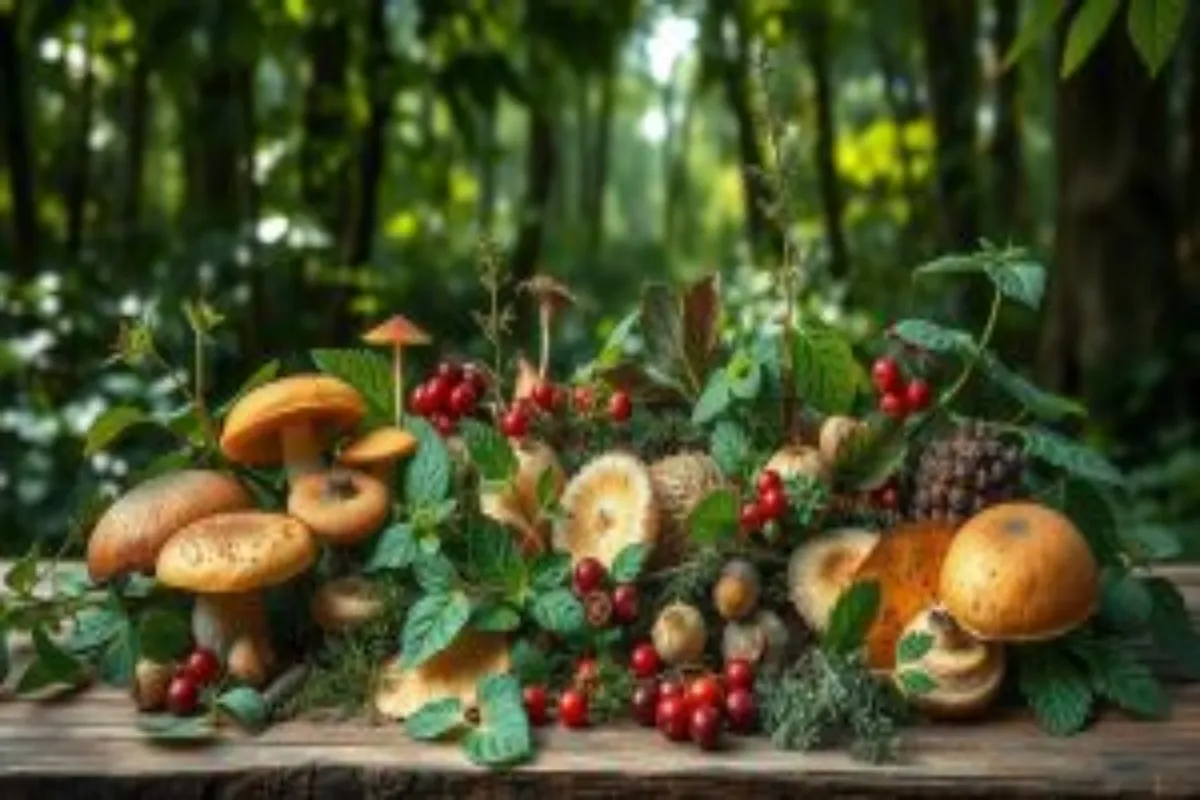Welcome to Nature’s Recipe Book, where we dive into wild culinary secrets. We’ll explore foraging for edible plants that can change your outdoor cooking. These plants add unique flavors and are good for you. They also connect us to nature and support sustainable living.
Key Takeaways
- Foraging opens up new flavors and culinary techniques.
- Edible plants enhance nutritional value in meals.
- Nurtures a deeper connection with nature.
- Promotes sustainable and eco-friendly cooking practices.
- Encourages people to explore local wild edible resources.
The Importance of Foraging for Edible Wild Plants
Foraging connects us to the earth and adds new flavors and nutrients to our meals. It helps us live in harmony with nature. Knowing how to forage is key for a safe and rewarding experience.
Understanding the Foraging Process
Foraging involves several important steps for success and safety. Knowing your local plants is crucial for finding the best ones. Watching how plants grow helps you gather them responsibly.
It’s important to know what edible plants look like. This knowledge makes foraging more effective.
Safety First: Identifying Edible vs. Toxic Plants
Always put safety first when foraging. Learning to tell edible from toxic plants is a must. Some plants may look alike but can be dangerous.
To stay safe, follow these tips:
- Get a good field guide for your area.
- Take foraging classes or join groups to learn from experts.
- Use all your senses—smell and touch are as important as sight.
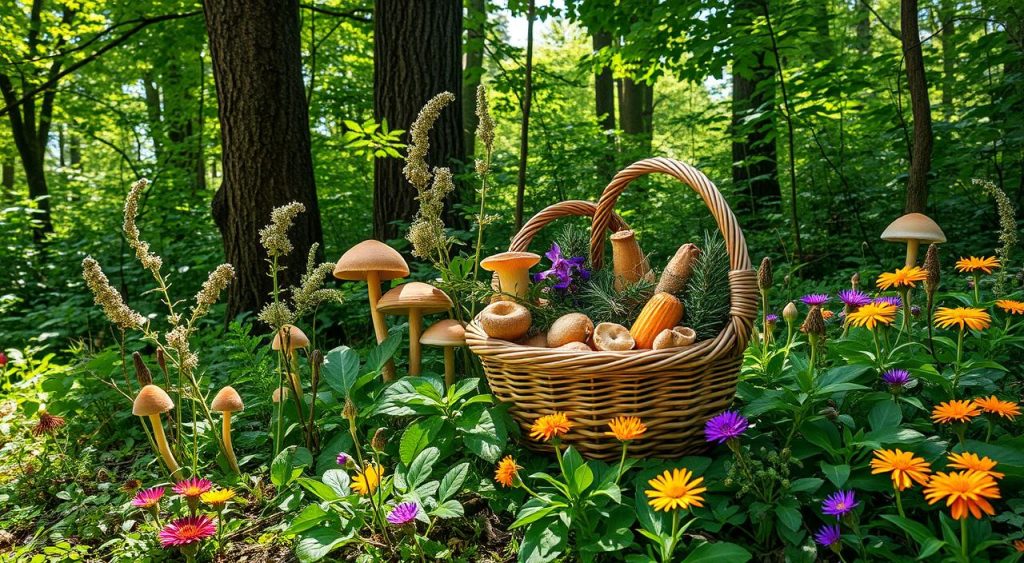
Nature’s Recipe Book: Rediscovering Traditional Cooking Techniques
Traditional cooking techniques link us to our culinary past. They let us explore flavors and experiences forgotten in today’s fast-paced world. This journey not only makes meals better but also brings back a love for living fully.
Ancient Methods Still Used Today
Techniques like smoking, drying, and fermenting are still key in traditional cooking. They keep ingredients true to nature and add deep flavors. Smoking gives fish and meats a rich taste, while drying fruits and herbs makes them sweeter and more fragrant.
These old ways are coming back, thanks to a new interest in cooking with nature. It’s all about going back to basics and valuing food’s true essence.
How Nature Influences Culinary Styles
The local environment greatly affects how we cook, bringing unique tastes and textures to our dishes. Ingredients from the wild inspire meals that show off the area’s culture and nature. This approach encourages creativity in the kitchen, using what the Earth offers.
This connection between cooking and nature shows a deeper way of living. It leads to healthier, more enjoyable meals. For those wanting to try this approach, resources like holistic nutrition recipes can help.
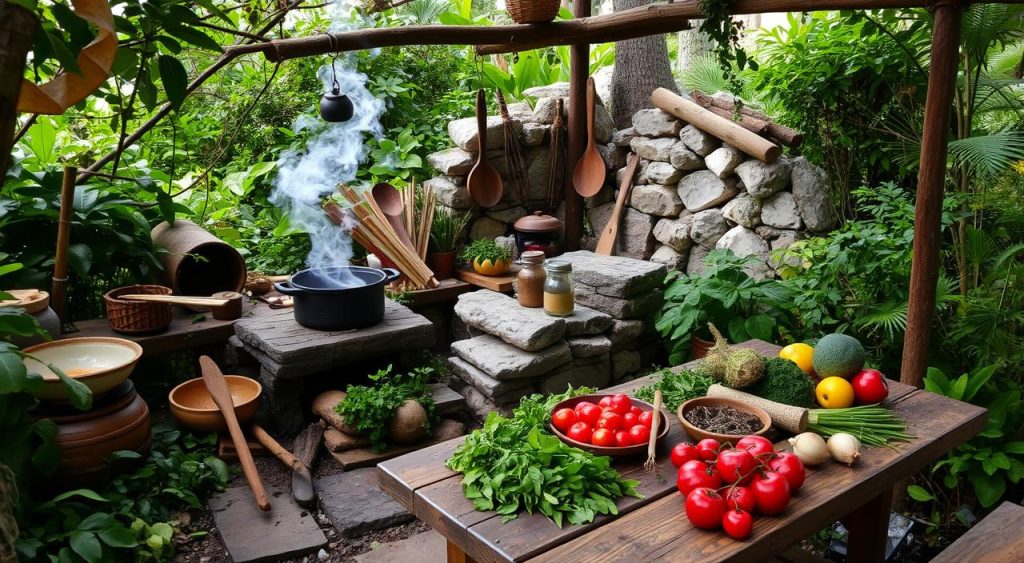
Essential Wild Ingredients for Your Pantry
Adding wild ingredients can change the game in your cooking. Things like edible herbs, foraged nuts, wild berries, and wild greens add flavor and health benefits. They are key for a healthy diet.
Herbs and Spices from the Wild
Wild herbs and spices add depth to dishes. Here are some common ones:
- Chickweed: Great fresh in salads or cooked into dishes.
- Wild Oregano: Makes pasta sauces and marinades taste better.
- Garlic Mustard: Adds a spicy kick to pesto or cooking.
These herbs make meals more nutritious and tasty, letting nature’s flavors shine.
Nuts and Berries: Nature’s Snacks
Foraged nuts and berries are great snacks. Here are some favorites:
- Black Walnuts: A bit bitter, they’re good in baked goods or as a snack.
- Acorns: After cleaning, they can be made into flour or add flavor to dishes.
- Wild Blueberries: Full of antioxidants, they’re tasty on yogurt or oatmeal.
These ingredients are not only nutritious but also add unique flavors that regular snacks don’t have.
Wild Greens: A Nutritional Powerhouse
Wild greens are great for your health. Here are some good ones:
- Dandelion greens: Rich in vitamins A and C, they’re good raw or cooked.
- Wild Sorrel: Adds a tangy taste to salads and goes well with fatty fish.
- Shepherd’s Purse: Its peppery taste is great in soups or sauces.
Adding wild greens to your diet helps you stay healthy and adds fresh flavors to your meals.
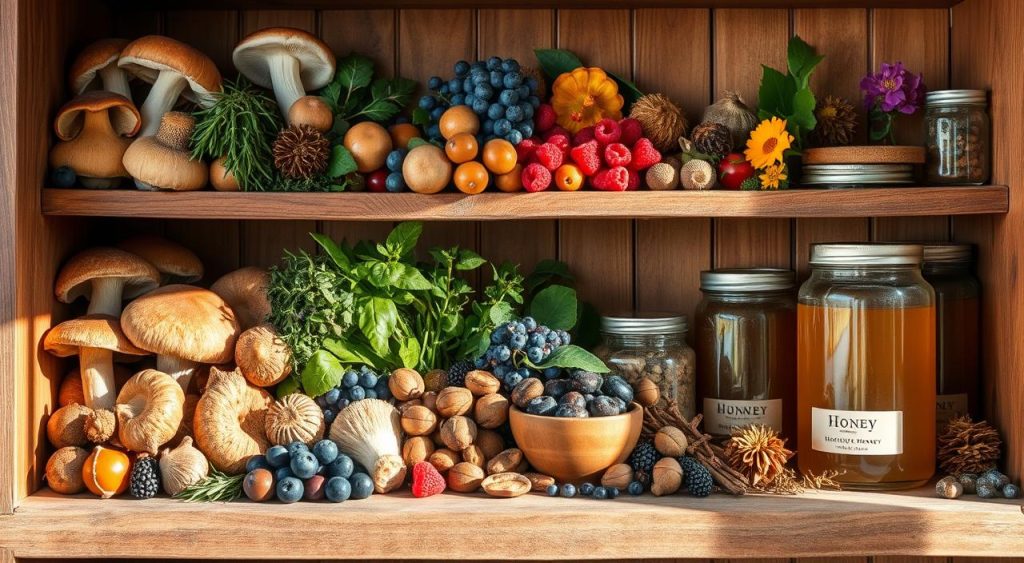
Seasonal Foraging: What to Look For Throughout the Year
Seasonal foraging is key for those wanting to use wild ingredients’ natural flavors. Each season brings its own set of edible plants. Knowing what to look for in spring, summer, fall, and winter makes foraging better and supports sustainable use.
Spring Delights: First Harvests of the Year
In spring, foragers find early flowers and fresh greens. This season offers a variety of nutritious plants, like:
- Wild leeks
- Garlic mustard
- Stinging nettles
- Dandelion greens
These plants symbolize life’s renewal and offer essential nutrients after winter.
Summer Staples: Fruits and Vegetables of the Season
Summer is the best time to gather delicious fruits. Foragers can find lots of:
- Berry bushes like blackberries and raspberries
- Wild plums
- Herbs such as basil and thyme
These fruits can be used in many recipes or eaten fresh, adding sweetness to summer meals.
Fall Finds: Preserving the Bounty
Fall is the time for preserving wild foods. This season is great for collecting:
- Acorns for flour
- Hazelnuts for snacks or baking
- Mushrooms for drying and keeping
Preserving methods like canning or drying let us enjoy wild foods even after the harvest season.
Winter Resources: Foods to Forage and Preserve
Winter foraging might seem scarce, but some plants are tough enough to survive the cold. Foragers can find:
- Wintergreen for flavoring
- Wood sorrel for its tangy taste
- Roots like dandelion or burdock for soups and stews
Using the right storage and preservation in winter lets foragers enjoy their finds all year long.
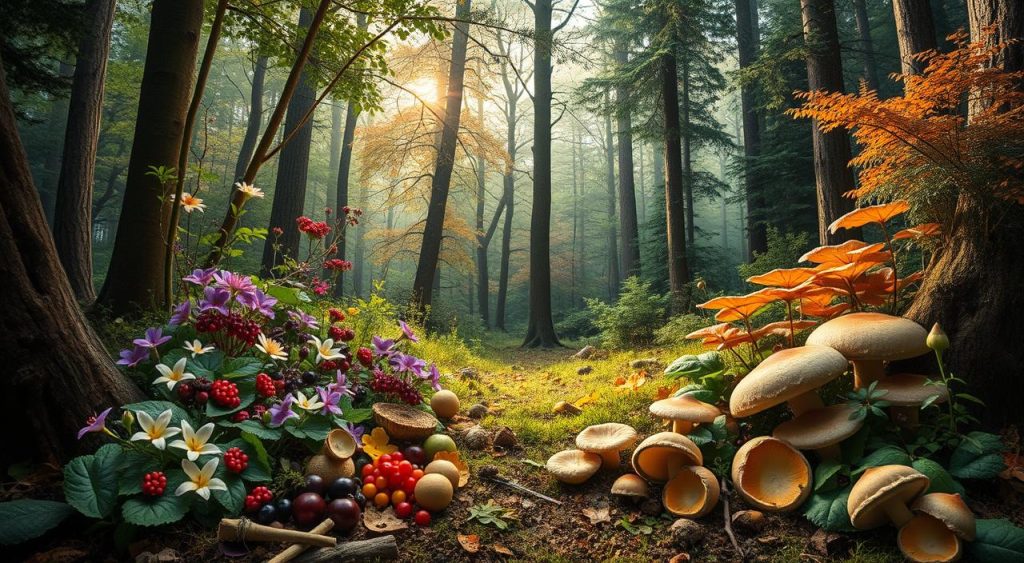
Cooking with Wild Ingredients: Tips and Techniques
Cooking with wild ingredients can make your meals more exciting. It brings unique tastes from nature right to your table. Learning how to prepare foraged food helps you get the best out of it. This way, you can enjoy traditional recipes with a wild twist.
Preparing Your Wild Ingredients for Cooking
Getting your foraged food ready is key. Here are some steps to keep your ingredients fresh and tasty:
- Cleaning: Rinse wild greens, herbs, and other items gently to get rid of dirt and bugs.
- Drying: Dry them with a clean cloth to stop moisture from affecting how they cook.
- Preserving: Freeze or dry them to keep them for later use.
Combining Wild Elements with Traditional Recipes
Adding wild flavors to traditional recipes can change the game. Here are some tips to spice up your cooking:
- Add wild herbs like lemon balm or mint to sauces or marinades for extra flavor.
- Use foraged greens like nettles or wild garlic instead of regular greens in salads.
- Put berries or nuts from nature into desserts for a new take on classic treats.
Being creative with wild ingredients lets you mix traditional recipes with new, exciting flavors. By preparing foraged food with care, you can enjoy the amazing tastes nature has to offer.
Creating Delicious Dishes from Nature’s Pantry
Exploring nature’s pantry opens up a world of culinary possibilities. Using foraged ingredients connects us with the environment and adds exciting flavors to our meals. Wild dish recipes can make everyday cooking unique. Let’s explore some ideas for wild appetizers, main courses, and desserts.
Appetizers: Wild Greens and Dips
Wild greens add a fresh touch to appetizers. Consider making dips that highlight their unique flavors. Here are some options:
- Dandelion and Garlic Dip: Blend dandelion leaves, garlic, and cream cheese for a savory spread.
- Wild Herb Pesto: Combine mixed wild herbs, nuts, olive oil, and cheese for an aromatic dip.
- Spruce Tip Hummus: Use young spruce tips in a classic hummus recipe for a citrusy twist.
Main Courses: Meat and Veggie Combinations
Foraged main courses can make your dinner special with wild meats and vegetables. Here are some ideas:
- Venison and Mushroom Stew: Add seasonal wild mushrooms to your stew for depth of flavor.
- Grilled Rabbit with Wild Greens: Pair roasted rabbit with a salad of assorted wild greens.
- Stuffed Squash with Wild Rice: Use foraged wild rice to create a filling that’s both unique and satisfying.
Desserts: Unique Sweet Treats from Nature
Natural desserts offer a refreshing change from traditional sweets. With the right ingredients, you can make delicious treats from nature’s gifts. Here are some ideas:
- Berry Crumble: Bake a mix of foraged berries under a crispy topping for a rustic dessert.
- Wildflower Honey Cheesecake: Sweeten a cheesecake with natural honey from wildflowers for delicate flavor.
- Maple and Pine Nut Cookies: Add foraged pine nuts and maple syrup for a delightful treat.
Foraging Etiquette: Respecting Nature’s Resources
Foraging lets us connect with nature, but we must always respect its resources. It’s important to follow foraging etiquette to keep these treasures safe for the future. Leave No Trace principles help us forage responsibly.
Leave No Trace Principles
Following Leave No Trace helps us reduce our impact and appreciate nature more. Foragers should remember these key points:
- Plan ahead and prepare to avoid harming the environment.
- Travel and camp on sturdy surfaces, not fragile ones.
- Dispose of waste correctly and take all trash with you.
- Leave natural and cultural spots as you found them for others.
These rules are key to keeping wild places beautiful. By following them, you show you care about sustainable foraging.
How to Sustainably Harvest Wild Foods
Sustainable foraging means taking only what you need to let nature flourish. Here are some tips:
- Make sure you can identify the plants you pick.
- Harvest in moderation to avoid harming the ecosystem.
- Avoid picking during times when plants are most vulnerable.
- Use tools that don’t harm the plants or their surroundings.
By doing this, foragers can respect nature and enjoy its gifts. This approach not only helps the environment but also makes foraging more rewarding for everyone.
Why Nature’s Recipe Book is Essential for Outdoor Enthusiasts
Outdoor cooking is more than just a way to feed our bodies. It’s a chance to reconnect with nature. By foraging, we can enjoy new flavors right outside our doors.
The Benefits of Cooking with Wild Ingredients
Cooking with wild ingredients makes meals unique and healthy. Wild foods are often fresher and packed with more nutrients. It helps us understand the local plants and animals, changing how we see food.
Connecting with Nature through Food
Foraging and cooking outside bring us closer to nature. When we gather ingredients, we connect deeply with the environment. This approach makes us more mindful and appreciative of nature’s balance.
Culinary Adventure: Exploring New Flavors
Foraging takes us on a culinary adventure. It teaches us to find and use different plants and mushrooms in our cooking. Every trip outside can lead to new tastes and textures, making cooking a creative journey.
Conclusion
Foraging is more than just finding food in the wild. It’s a journey that lets you explore nature’s culinary treasures. By following the tips and techniques in this article, you’ll grow to love the wild ingredients that can make your cooking special. You’ll learn to appreciate the rich flavors of seasonal herbs and the unique texture of wild greens.
Foraging lets you connect more deeply with nature. It changes how you see food and where it comes from. Every meal made with wild ingredients not only feeds your body but also strengthens your bond with the earth.
It’s important to encourage foraging as a way to connect with the land. Let it inspire you to try new things in the kitchen. By using foraging in your cooking, you’ll open up a world of flavors. Take the chance, explore nature’s bounty, and make dishes that celebrate your new skills and the environment.
FAQ
What is foraging and why is it important?
Foraging means looking for and picking wild foods like plants, fruits, nuts, and herbs. It’s key for connecting with nature, supporting biodiversity, and finding healthy food. It also makes our meals fresh and full of nutrients.
How can I safely identify edible wild plants?
Safety first in foraging. Use a trusted field guide or plant identification apps to find edible plants. Join foraging groups or classes for hands-on learning. Always check a plant’s safety before eating it and get expert advice when unsure.
What traditional cooking techniques can be used with foraged ingredients?
Use old-school cooking methods like smoking, drying, fermenting, and pickling to boost wild food flavors. These ways not only keep the food fresh but also make it taste better. They help you connect with your cooking roots and enjoy nature’s flavors in your dishes.
What are some essential wild ingredients I should include in my pantry?
Keep wild herbs like wild garlic and dandelion greens, and nuts like acorns and berries like blackberries and raspberries in your pantry. Adding these to your meals increases nutrition and brings unique tastes to your food.
How does seasonal foraging vary throughout the year?
Foraging changes with the seasons. Spring brings early greens like nettles. Summer is full of berries and fruits. Fall is best for nuts and mushrooms. Winter offers conifer needles and roots, showing the need to know what and when to harvest.
What are some tips for cooking with wild ingredients?
Clean and dry wild ingredients before cooking. Try wild garlic instead of regular garlic in recipes. Focus on dishes that highlight the wild ingredients’ unique tastes while keeping the meal tasty.
How do I practice responsible foraging etiquette?
Follow Leave No Trace to minimize your impact on nature. Harvest only what you need and avoid harming wildlife or habitats. Learn about local rules and respect private lands for ethical foraging.
What are the benefits of incorporating wild ingredients into my meals?
Adding wild ingredients to your meals boosts flavors, nutrition, and your connection to nature. It encourages trying new foods and dishes inspired by the outdoors.

